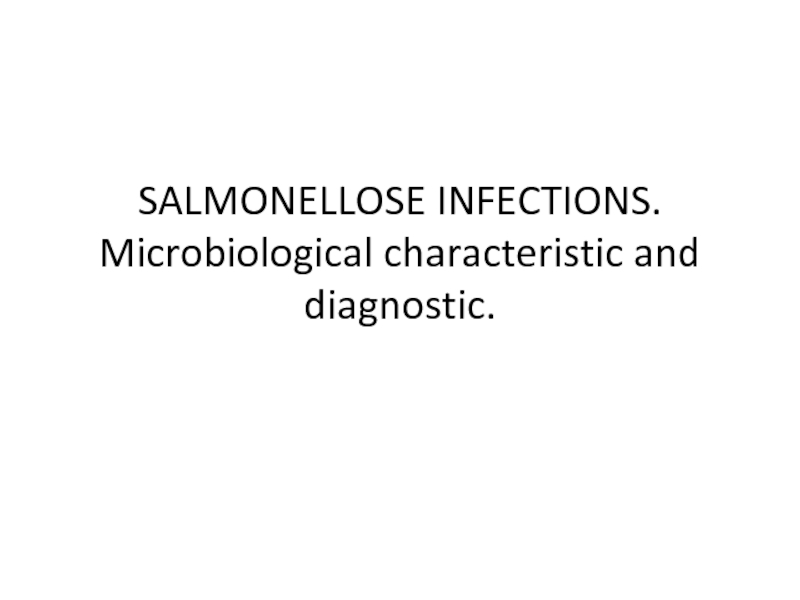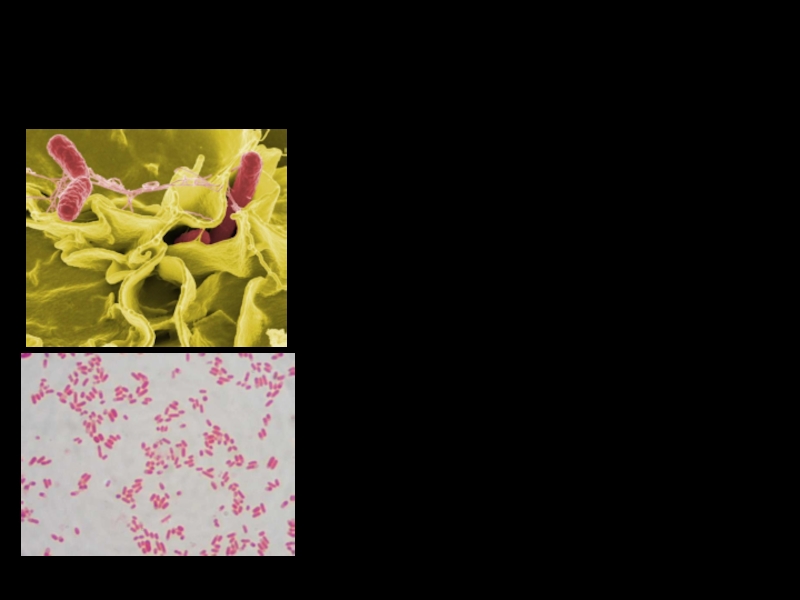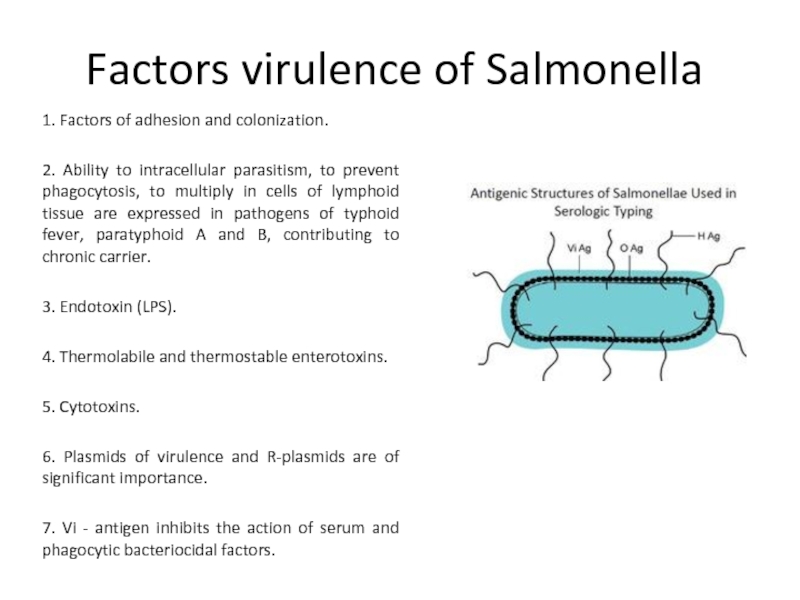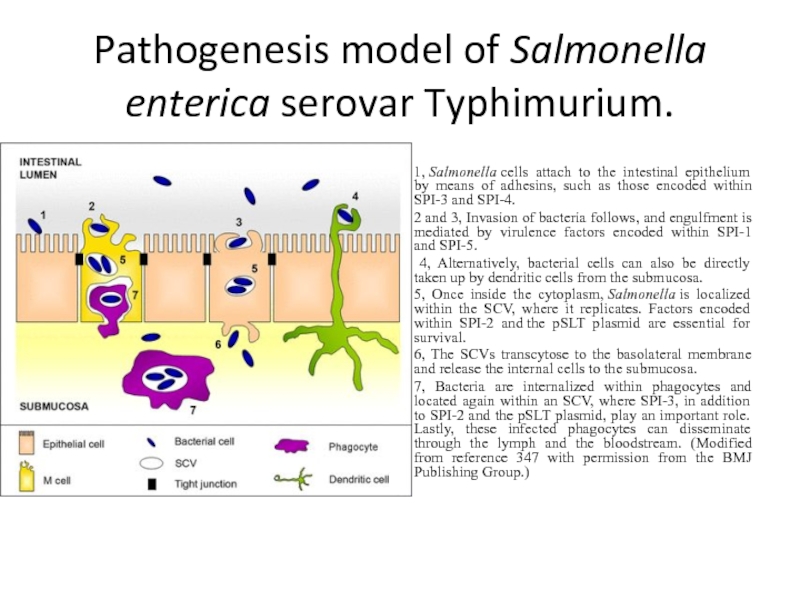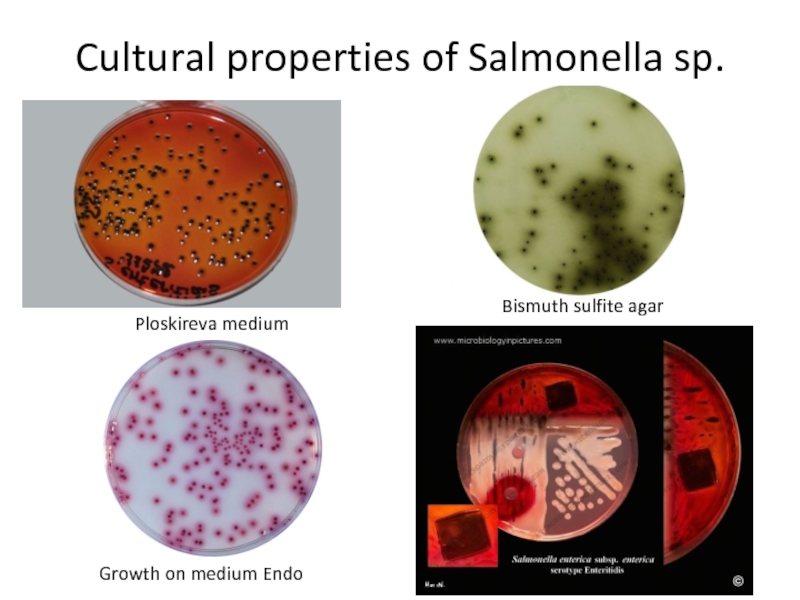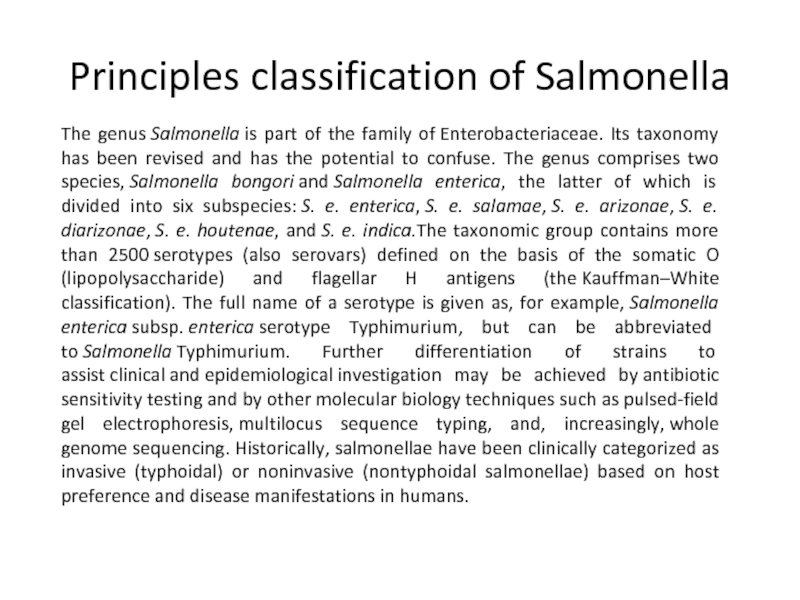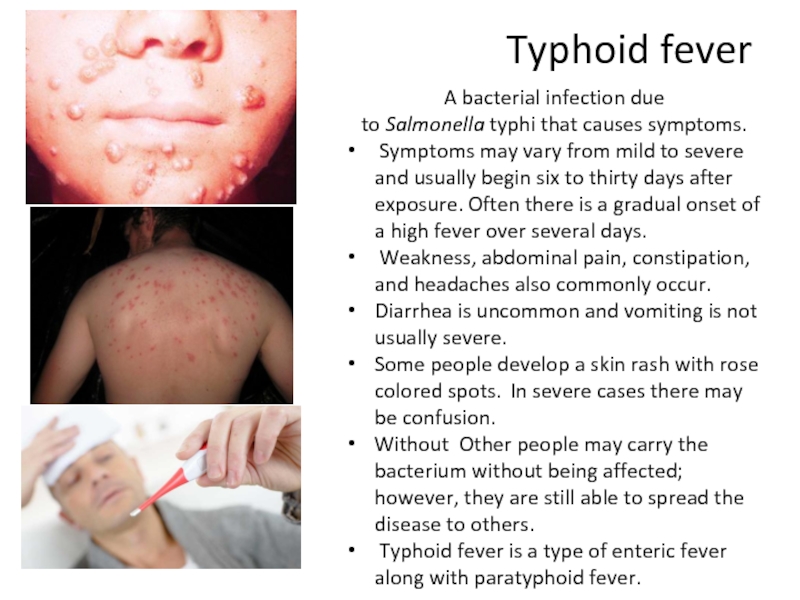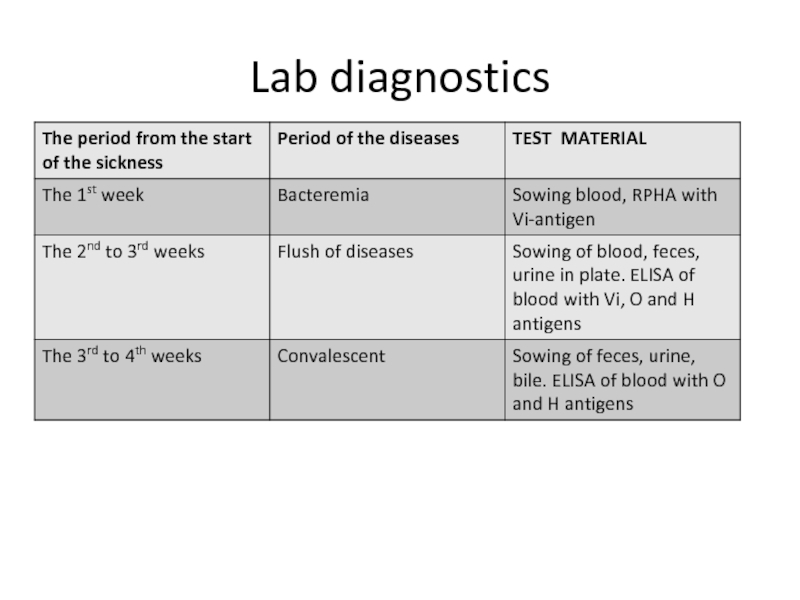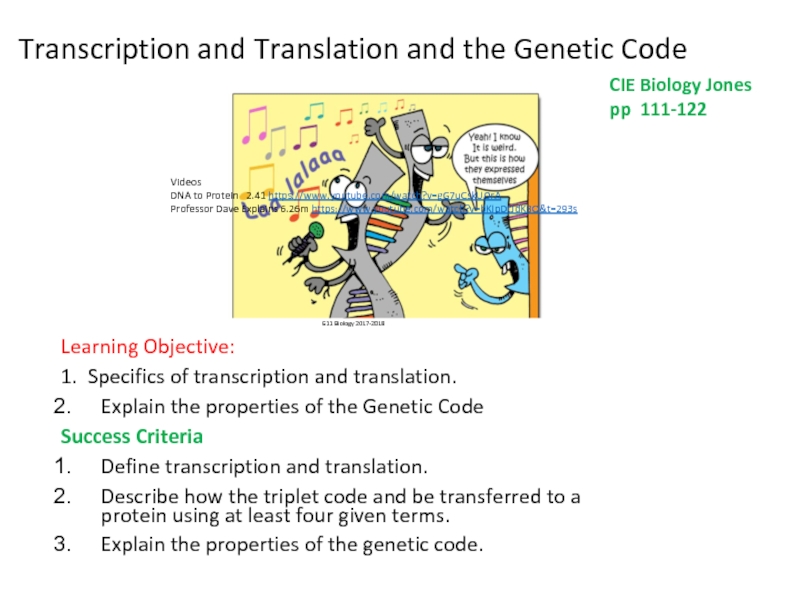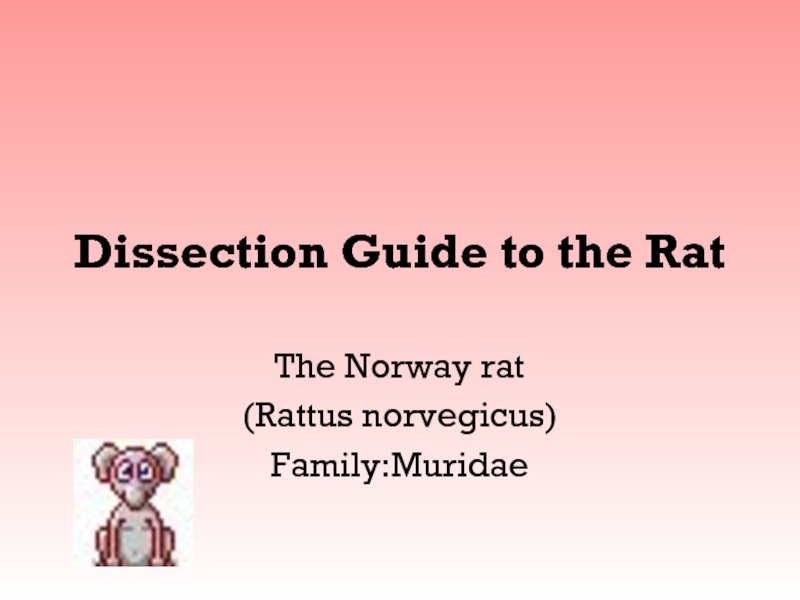- Главная
- Разное
- Дизайн
- Бизнес и предпринимательство
- Аналитика
- Образование
- Развлечения
- Красота и здоровье
- Финансы
- Государство
- Путешествия
- Спорт
- Недвижимость
- Армия
- Графика
- Культурология
- Еда и кулинария
- Лингвистика
- Английский язык
- Астрономия
- Алгебра
- Биология
- География
- Детские презентации
- Информатика
- История
- Литература
- Маркетинг
- Математика
- Медицина
- Менеджмент
- Музыка
- МХК
- Немецкий язык
- ОБЖ
- Обществознание
- Окружающий мир
- Педагогика
- Русский язык
- Технология
- Физика
- Философия
- Химия
- Шаблоны, картинки для презентаций
- Экология
- Экономика
- Юриспруденция
Salmonellose infections. Microbiological characteristic and diagnostic презентация
Содержание
- 1. Salmonellose infections. Microbiological characteristic and diagnostic
- 2. Family: Enterobacteriaceae Genus: Salmonella spp.
- 3. Factors virulence of Salmonella 1. Factors
- 4. Pathogenesis model of Salmonella enterica serovar Typhimurium. 1, Salmonella cells attach
- 5. Cultural properties of Salmonella sp. Bismuth sulfite agar Ploskireva medium Growth on medium Endo
- 6. Kligler iron agar Change in color to
- 7. Principles classification of Salmonella The genus Salmonella is part
- 8. Typhoid fever A bacterial infection due
- 9. Lab diagnostics
Слайд 2 Family: Enterobacteriaceae
Genus: Salmonella spp.
Characteristic: facultative anaerobes, gram-negative bacillus with
size 2-4 x 0,5 microns. They are mobile due to the presence of peritrichrally located flagella.
Specialty: Infectious disease
Symptoms: Diarrhea, fever, abdominal cramps, vomiting
Biochemical properties: Do not fermente lactose or sucrose, produce acid and gas from glucose – S. typhi is gas negative, produce H2S.
Specialty: Infectious disease
Symptoms: Diarrhea, fever, abdominal cramps, vomiting
Biochemical properties: Do not fermente lactose or sucrose, produce acid and gas from glucose – S. typhi is gas negative, produce H2S.
Salmonella sp. Gram stain
Слайд 3Factors virulence of Salmonella
1. Factors of adhesion and colonization.
2. Ability
to intracellular parasitism, to prevent phagocytosis, to multiply in cells of lymphoid tissue are expressed in pathogens of typhoid fever, paratyphoid A and B, contributing to chronic carrier.
3. Endotoxin (LPS).
4. Thermolabile and thermostable enterotoxins.
5. Cytotoxins.
6. Plasmids of virulence and R-plasmids are of significant importance.
7. Vi - antigen inhibits the action of serum and phagocytic bacteriocidal factors.
3. Endotoxin (LPS).
4. Thermolabile and thermostable enterotoxins.
5. Cytotoxins.
6. Plasmids of virulence and R-plasmids are of significant importance.
7. Vi - antigen inhibits the action of serum and phagocytic bacteriocidal factors.
Слайд 4Pathogenesis model of Salmonella enterica serovar Typhimurium.
1, Salmonella cells attach to the intestinal epithelium by
means of adhesins, such as those encoded within SPI-3 and SPI-4.
2 and 3, Invasion of bacteria follows, and engulfment is mediated by virulence factors encoded within SPI-1 and SPI-5.
4, Alternatively, bacterial cells can also be directly taken up by dendritic cells from the submucosa.
5, Once inside the cytoplasm, Salmonella is localized within the SCV, where it replicates. Factors encoded within SPI-2 and the pSLT plasmid are essential for survival.
6, The SCVs transcytose to the basolateral membrane and release the internal cells to the submucosa.
7, Bacteria are internalized within phagocytes and located again within an SCV, where SPI-3, in addition to SPI-2 and the pSLT plasmid, play an important role. Lastly, these infected phagocytes can disseminate through the lymph and the bloodstream. (Modified from reference 347 with permission from the BMJ Publishing Group.)
2 and 3, Invasion of bacteria follows, and engulfment is mediated by virulence factors encoded within SPI-1 and SPI-5.
4, Alternatively, bacterial cells can also be directly taken up by dendritic cells from the submucosa.
5, Once inside the cytoplasm, Salmonella is localized within the SCV, where it replicates. Factors encoded within SPI-2 and the pSLT plasmid are essential for survival.
6, The SCVs transcytose to the basolateral membrane and release the internal cells to the submucosa.
7, Bacteria are internalized within phagocytes and located again within an SCV, where SPI-3, in addition to SPI-2 and the pSLT plasmid, play an important role. Lastly, these infected phagocytes can disseminate through the lymph and the bloodstream. (Modified from reference 347 with permission from the BMJ Publishing Group.)
Слайд 5Cultural properties of Salmonella sp.
Bismuth sulfite agar
Ploskireva medium
Growth on medium
Endo
Слайд 6Kligler iron agar
Change in color to yellow (acidification) - LACTOSE AND
Sucrose FERMENTATION
Blackening of the environment - PRODUCTION OF H2S
Changes in coloring to yellow (acidification) - FERMENTATION OF GLUCOSE TO ACID. The same + gas - FERMENTATION of glucose to acid and gas.
Change in color on bright crimson (alkalinization) - FERMENTATION of the ureter.
Blackening of the environment - PRODUCTION OF H2S
Changes in coloring to yellow (acidification) - FERMENTATION OF GLUCOSE TO ACID. The same + gas - FERMENTATION of glucose to acid and gas.
Change in color on bright crimson (alkalinization) - FERMENTATION of the ureter.
Слайд 7Principles classification of Salmonella
The genus Salmonella is part of the family of Enterobacteriaceae. Its
taxonomy has been revised and has the potential to confuse. The genus comprises two species, Salmonella bongori and Salmonella enterica, the latter of which is divided into six subspecies: S. e. enterica, S. e. salamae, S. e. arizonae, S. e. diarizonae, S. e. houtenae, and S. e. indica.The taxonomic group contains more than 2500 serotypes (also serovars) defined on the basis of the somatic O (lipopolysaccharide) and flagellar H antigens (the Kauffman–White classification). The full name of a serotype is given as, for example, Salmonella enterica subsp. enterica serotype Typhimurium, but can be abbreviated to Salmonella Typhimurium. Further differentiation of strains to assist clinical and epidemiological investigation may be achieved by antibiotic sensitivity testing and by other molecular biology techniques such as pulsed-field gel electrophoresis, multilocus sequence typing, and, increasingly, whole genome sequencing. Historically, salmonellae have been clinically categorized as invasive (typhoidal) or noninvasive (nontyphoidal salmonellae) based on host preference and disease manifestations in humans.
Слайд 8Typhoid fever
A bacterial infection due to Salmonella typhi that causes symptoms.
Symptoms may vary from
mild to severe and usually begin six to thirty days after exposure. Often there is a gradual onset of a high fever over several days.
Weakness, abdominal pain, constipation, and headaches also commonly occur.
Diarrhea is uncommon and vomiting is not usually severe.
Some people develop a skin rash with rose colored spots. In severe cases there may be confusion.
Without Other people may carry the bacterium without being affected; however, they are still able to spread the disease to others.
Typhoid fever is a type of enteric fever along with paratyphoid fever.
Weakness, abdominal pain, constipation, and headaches also commonly occur.
Diarrhea is uncommon and vomiting is not usually severe.
Some people develop a skin rash with rose colored spots. In severe cases there may be confusion.
Without Other people may carry the bacterium without being affected; however, they are still able to spread the disease to others.
Typhoid fever is a type of enteric fever along with paratyphoid fever.
